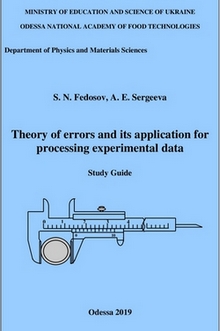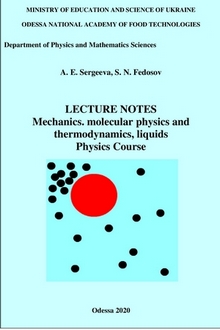S.N. Fedosov, A.E. Sergeeva. Theory of Errors and its Application for Processing Experimental Data.- Odessa: ONAFT.- 2019
A.E. Sergeeva, S.N. Fedosov. Lecture Notes. Physics Course.- Odessa :ONAFT.- 2020
INSTRUCTIONS FOR A STUDENT
- WORK OF THE THEORETICAL MATERIAL
Each student must maintain a lecture notes. The quality of the elaboration of the theoretical material in the lecture notes influences the grade obtained during the exam. It is necessary to refine the material outlined during the lecture by using textbooks and the Internet.
The student should attempt to UNDERSTAND the theoretical material. At the lectures, the first acquaintance with this material takes place, the main purpose of which is to understand it. Do not hesitate to raise your hand and ask the teacher to clarify the situation, which seems to you not entirely clear, in more detail. By studying the theoretical material, you form the basis of the concepts and laws of physics (study the “language” of physics) and learn to apply these concepts and laws to specific situations (you form “the physical thinking”).
In the lecture notes, always highlight definitions of physical concepts and the wording of laws. This will help you to form the basis of your knowledge. For the formation of physical thinking you need to understand how the basic principles of physics are derived. In the lecture notes, always highlight the structural elements of the conclusions, namely, the formulation of the problem, the compilation of the initial system of equations, the solution of these equations, the obtaining of the final formula, its analysis and the limits of applicability.
Before each lecture, review the summary of the previous lecture, then the current lecture will be more understandable. Questions that are proposed for self-study, should be elaborated and outlined by a student himself or herself.
To assimilate the material, it is necessary to learn to think logically, completely eliminating mechanical memorization. It is necessary to work on the lecture notes “with a pencil in hand,” working through all the conclusions and evidence, not limited to just reading the material.
- PREPARATION FOR A PRACTICAL WORKSHOP
In preparation for the practical lesson, the student should, first of all, study the relevant theoretical material. The student can check himself the level of the theoretical material understanding during independent work, for example, by solving the problems recommended for independent work.
After studying the theoretical material, please write in the notebook the topic of the lesson and the list of basic formulas with an explanation of all notations (each symbol in the formula).
Next, you need to learn examples of problem solving. If the example is incomprehensible to you, write down the question to the teacher and get an answer to it during practical exercises. The main difficulty in solving the problem is the compilation of a system of equations describing the processes referred to in the problem. Therefore, while analyzing examples of problems solving, pay attention, first of all, to how the system of equations is composed. Work on the examples of problems “with a pencil in your hands,” working through all the features of the solution.
Next you should start solving the problems of your homework. To do this, write down the topic of the lesson, the number and full text of the problem in the exercise book, mark all physical quantities in Latin or Greek letters, write down a brief description of the problem, convert all values into the SI system, draw a picture on which you can mark those values involved in the problem.
The next step is to write down the basic formulas and definitions of the quantities to be used while solving the problem. Using these formulas, compose a system of equations describing the processes referred to in the problem. Be sure to write down explanations and comments on the formulas so that it will be clear where these formulas come from.
Further, using algebraic actions, the system of equations should be solved, i.e. you should get a solution in general form (calculation formula). Then it is necessary to substitute the numerical values in the SI system into the calculation formula and to obtain the final result. Check the result with the correct answer at the end of the problem book. It is very useful to analyze the received result: does the real value correspond to the obtained value (for example, the speed of the ball can under no circumstances exceed the speed of light)
For each SELF-SOLVED home task, the student receives additional points.
- PREPARATION FOR PERFORMING LABORATORY WORKS
Before performing laboratory work, it is necessary to familiarize yourself with its description in the guidelines. Using the guidelines, it is necessary to prepare a laboratory work report. The protocol should include: a title page with the number and name of the work, the name and group of the student, the purpose of the work, instruments and materials, a brief description of the experimental setup and research method, the order of the work done, the results obtained when the work was done, and the main conclusions.
Before performing laboratory work, it is necessary to elaborate the theoretical material related to the law or phenomenon under study. To do this, use the lecture notes, textbooks, teaching materials for laboratory work, and other materials. Using the guidelines, find out for yourself what measurements and calculations need to be made to make sure, for example, whether or not the physical law is being complied with. To test your knowledge, use control questions formulated for each laboratory work. You should answer these questions and similar questions while admitting to the performing the laboratory work and for defending it.
To perform laboratory work, the student must obtain the admission of a teacher who checks the theoretical knowledge of the student on the subject of laboratory work, as well as knowledge of the experimental setup and research methods.
During the performing of the laboratory work, the student must carry out experimental measurements, and perform draft calculations. The teacher browses through the obtained results and signs the protocol. Laboratory work is considered as completed.
For defending the laboratory work, it is necessary to register the results of measurements and calculations in the “Work performance” section. It is necessary to fill in the tables, make calculations, write down the formulas, substitute the obtained values of the quantities into the formulas and write down the numerical result. You should write conclusions after analyzing the obtained results.
During the interview with the teacher, the theoretical knowledge of the student on the subject of laboratory work, knowledge of the experimental setup and research methods, the accuracy and accuracy of the results obtained are checked. Work is considered as finally defended, if the student gets a positive assessment.
The protocol of the laboratory work should be made out neatly, since the quality of its making out affects the assessment received by the student for the performance of the laboratory work.
WE WISH YOU GOOD LUCK!


